“The core essence of Mars City Design is —not to repeat the same mistakes that we did to our planet. The hope to start a new design for living on Mars, every single thing needs to have a sustainable answer within the big picture, of the regenerative circle of life and of the product itself. All things need an exit plan that allows them to be reusable or repurposed. That can hopefully inspire change on Earth.”
-Vera Mulyani (Vera Mars), Founder/CEO Mars City Design
Once the stuff of science fiction, the possibility that humans could establish a permanent settlement on Mars now appears to be a genuine possibility. While doing so represents a major challenge and there are many hurdles that still need to be overcome, the challenge itself is inspiring some truly creative solutions. But what is especially interesting is how these same solutions can also address problems here on Earth.
This is especially clear where the Mars City Design Challenges are concerned. This annual competition was founded with the purpose of inspiring innovative ideas that could lead to sustainable living on Mars. For this year’s challenge, “Urban Farming for Extreme Environment,” Mars City Design and its founder (Vera Mulyani) are looking for designs that incorporate urban farming to support a colony of 100 people.
Born in Jakarta, Mulyani began contemplating how humans might live on Mars at a young age. After completing her education as an architect, she eventually moved to California and became inspired by the rise of the NewSpace industry. In particular, it was Elon Musk’s vision of making humanity an interplanetary species that captured her imagination and made her want to apply her talents to “going interplanetary”.
As Mulyani told Universe Today via email, the same dream that inspired her as a child are still what motivates her today:
“It is important to know that sky is not the limit. That we also have no limit to how far we’d like to expand as a human species. That bigger dreams force us to unite as human beings, instead of competing against each other. Because that scarcity may come from a false belief that there is only a limited resource. It is far happier to live by creating value together, uncovering the unlimited resource on Mars or else than spending the same amount of effort to fight against each other on one limited Earth resource.”
In 2015, Mulyani founded Mars City Design (MCD), an innovation platform where teams from around the world are able to come together with industry experts and share their ideas. Every year, the challenge has a different theme, but all are focused on the bigger question of how housing and urban designs can allow humans to not only survive on Mars, but thrive!
At the heart of MCD are the design competitions and they have hosted every year since foundation. The focus of these competitions is the creation of field project designs that explore the feasibility of future Martian cities, as well as technologies that will allow for sustainable living on Mars. In addition to engineers and scientists, the competition also attracts artists and visionaries who want to bring a certain flair to off-world living.
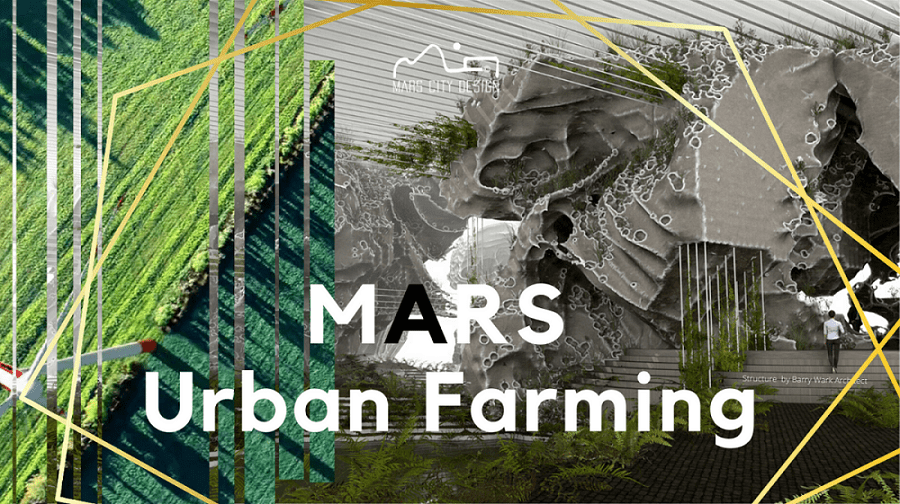
“MCD facilitates access to the space industry,” said Mulyani. “We call the people from creative backgrounds, architecture, design, to join the engineering teams. We use our educational platform, annual contest to design the Mars settlements. Governments, corporations, and academics unite to solve common challenging issues for human wellbeing in this extreme environment design.”
After every competition, Mulyani and MCD select the teams and individuals that they’d like to work with and invites them to join their efforts. They then have the privilege of building a prototype of their design on the MCD property in the Mojave desert, where the geological conditions are quite similar to those found on the Moon and Mars. In addition, every competition has a general theme that emphasizes a different aspect of life.
For example, the 2016 competition kicked things off with a focus on the general theme of “Urban Design and Architecture.” The theme for 2017 was “AI Robotics and Engineering,” while 2018 and 2019 were concerned with transportation and sports, respectively. This year, as Mulyani explained, the theme is “Urban Farming,” where teams will be tasked with designing buildings that can accommodate agricultural operations:
“Every year we have a different theme. This year specifically we want to focus on the food supply and so the systems that can provide this. Again, we put the importance to not just cover the basics, how long can we really stay, if we only eat potatoes every day?”
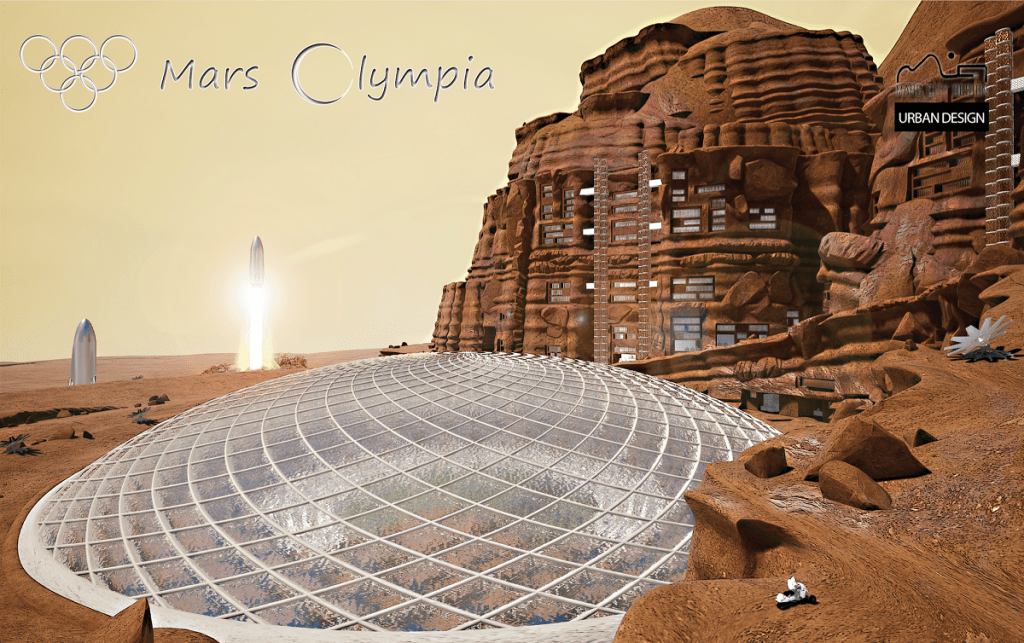
Here, Mulyani is referencing not only the well-known thread from Andy Weir’s The Martian, but also a scene from Netflix’s Space Force, where astronauts in a simulated lunar habitat are forced to eat nothing but potatoes. As General Naird (Steve Carell) says in the course of inspecting the habitat, “You guys really doubled-down on the potatoes! Ever think of growing some asparagus?”
“We will start with a delicious menu that can stimulate the crew’s motivation to continue living with joy, then think backward on how we can supply the ingredients self-sustainably,” Mulyani added. “If not? For example, one likes only some “Boeuf Bourguignon” but mom is not with her on Mars? Can we find an alternative way to make this food or do we train to become a vegetarian? Should we grow these animal-based foods? How?”
While a different theme is highlighted every year, the others are still included as part of with each competition. At the end of each competition, awards are assigned for different types of innovations, including architecture, design, transportation, sustainable energy, artificial intelligence, virtual reality/augmented reality applications, and others.
The overall emphasis on sustainability is something Mulyani is no stranger to. After earning her Masters in Architecture, Landscape, and Urban Design from the Ecole d’Architecture de Nantes, she moved to New York. It was here that she divided her time between film-making and designing ways to convert damaged industrial areas into sustainable “Green Zones” by incorporating the natural environment into human living spaces.
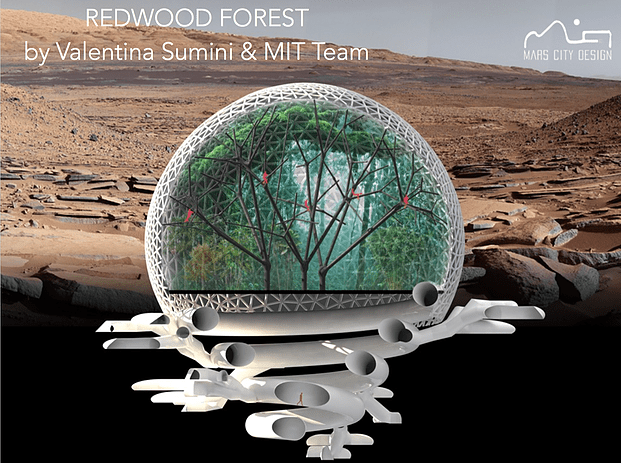
As for where these habitats and Martian cities will be built once humans get to Mars, that is something these competitions are exploring as well. While many proposals have recommended building Martian settlements underground or in lava tubes (to take advantage of the natural radiation shielding), MCD strongly suggests that designers consider innovations that will allow for safety while preventing feelings of isolation.
This includes the use of materials that can provide shielding from radiation while also creating transparency – i.e. advanced glass facades. As Mulyani asks, why should anyone go to the Moon or to Mars if they are only going to live underground with no natural light or a view? In this sense, MCD is motivated to find innovative solutions rather than “reactionary problem solving.”
A popular idea is to build within Valles Marineris, a natural system of canyons that run east-west near the Tharsis volcanic region. In the past, proponents of Martian settlement have advocated for this location because natural depressions on Mars are where atmospheric pressure is highest. Compared to the planetary average of 6 mbar (0.6% of Earth), atmospheric pressure in Valles Marineris gets up to 11 mbar (1% that of Earth).
Similarly, in the massive southern crater of Hellas Planitia, air pressure can get as high as 12.4 mbar – still very thin, but twice the planetary average. Once again, the purpose here is to look beyond mere survival and create conditions that are liveable. Said Mulyani:
“We are studying a few different places that have the safety characteristics on Mars that can also provide scientific interests for the trip’s missions. We believe – again – we are not limited to the past vision of ‘living underground.’ There are not enough favorable configurations in the characters of the lava tubes or underground in question, other than to be safe. We want to expand the vision from surviving to thriving.”
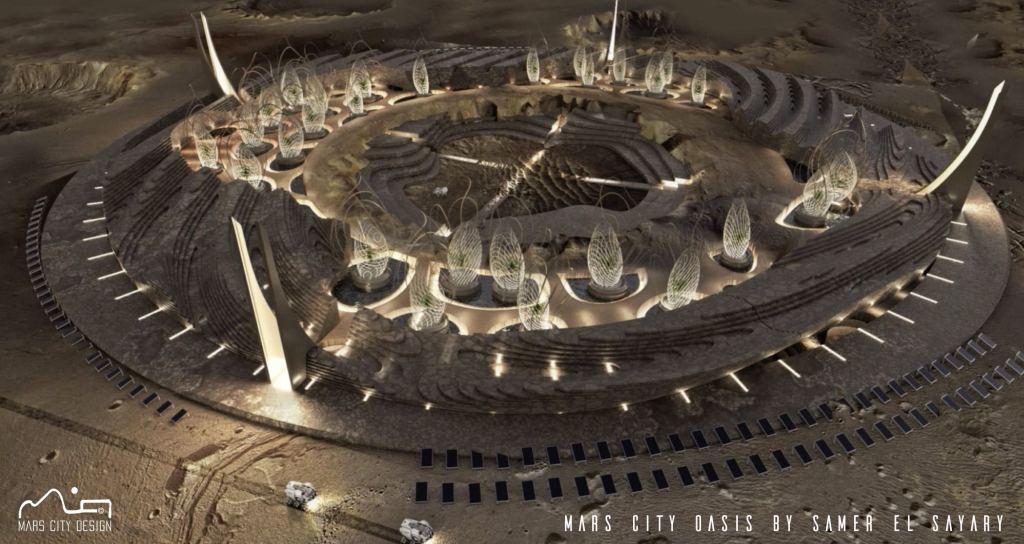
To raise awareness about Martian exploration and sustainable living, MCD also participates in competitions and events with other organizations. For example, last year they took part in the NASA 3D-Printing Habitat Challenge. Their entry, Alpha 3.0, was inspired by the dark, naturally-occurring dunes that are found in a crater located in the larger Syrtis Major Planum formation.
This area is rich in ice water and mineral resources, which the Alpha Team would leverage to create their habitats within the walls of the local dunes. This would provide natural insulation and shielding from radiation and micrometeoroids while still allowing for access to (and views of) the surface, ensuring that the inhabitants feel connected to the surrounding environment.
Their concept was part of Phase 3 of the competition – aka. the On-Site Habitat Competition – where teams were tasked with fabricating sub-scale models of their habitats. Their entry was one of the top 10 winners of the 2019 competition, and the prototype will be assembled by MCD in the Mojave desert.
There’s also the Martian Feast Gala, a non-profit fundraiser that MCD has been hosting for the past eight years. Last year’s event, the Martian Feast 1010 (held on Oct. 10th, 2019 in Culver City, California) featured guest speakers, musicians, artists, luminaries, and members of the NewSpace industry. It also featured examples of “Martian cuisine,” which consisted of superfoods grown using a zero-waste process.
This past March, Mulyani also collaborated with Photo Zurich last year to create the Micro-Macro Universe project. This photo exhibition showcased original images of Earth, space, and human beings (taken by Mulyani and colleagues) for the purpose of showing how everything in the Universe is a matter of scale. This, said Mulyania, is crucial to her understanding of nature as well as her architectural design process.
In the meantime, MCD is working on the creation of the Mars City Research Center, a small urban infrastructure concept that is being built in the Mojave Desert. Dubbed “A Space Oasis,” this location will consist of self-sustaining human habitats run on clean energy, and will include housing and laboratories that will be available for space startups and space organizations.
Once complete, Mars City will also host science retreats, an aerospace kindergarten (educating the young about how space exploration benefits life on Earth), and Martian farming experiments – where scientists will attempt to find optimal solutions for growing crops in Martian soil simulants, paralleling research conducted by NASA and various research labs.
In short, Mars City is a prototype of what MCD hopes to one day build on the surface of Mars. When that happens, all of the concepts, prototypes, innovations, and ideas that Mulyani and her organization have inspired over the years will be applied and leveraged to create the first sustainable human city ever built on another planet.
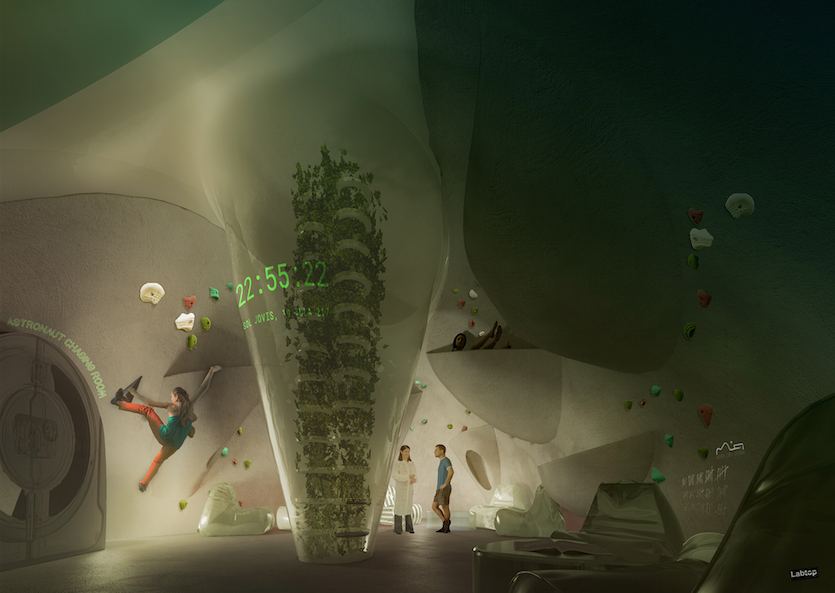
For this year’s competition, Mulyani also emphasized how recent events (the COVID-19 pandemic) have helped to raise awareness about “living in isolation.” This, as she indicated, provides valuable lessons when it comes to the prospect of living on Mars:
“Our point of view in this is still based on our belief about “living beyond survival” and thriving. It is crucial to create an indoor living space that gives us outdoor comfort. Incorporating all aspects of our activities into the living place. We may eliminate the torture of constant traffic jams and pollution in the long run. Building self-reliability and teaching that to the next generation. All can be done in house and locally.”
This year’s competition promises to be an inspiring one. The entries will be judged by a panel that includes NASA astronaut Col. Terry Virts, ecology expert Mackenzie McAller (CEO of Geonauts), and architectural professor Samer El Sayary. The winning submission will receive The Mars City Design Award, international recognition, and will see their design added to the MCD “hall of fame” in the Mojave desert.
Those interesting should check out the Mars City Design competition page, and their registration page on Eventbrite. Registration will remain open until August 30th, 2020, and the window for submissions closes at 11:59 p.m. PDT on Sept. 15th, 2020 (02:59 a.m., Sept. 16th, EDT). The winner of this year’s competition will be announced on October 1st.
Be sure to check out this recent interview with Guide Force, where Mulyani shares the lessons she has learned regarding how one takes a dream from the conceptual stage to reality. And be sure to check out this MCD video that describes the purpose and vision of their organization and features commentary by Andy Weir, Slade Gardner (founder of Big Metal Additives) and NASA scientist Kip Thorne:
Further Reading: Mars City Design


To maximize crop yields on Mars it would be advantageous to do away with annuals and biannuals by engineering the latter into perennials as standard. Not only would that entail far less work to grow produce as the act of replanting is made obsolete, but per given cultivated area perennials bring forth more food and materials with less demand from the soil than the equivalent of annuals.
Imagine a superfood annual such as lentils engineered into a lentil tree for which there already are perennial equivalents in the legume family as we know thanks to the permaculturalists’listed plant species stock. Permaculture would be the ideal manner in which to create ecosystems in outer space of other planets such as Mars. Permaculture designs whole habitats from model templates known to work well together, out of ethnobotanical or zoological species that exactly match and thrive as a community in distinct environmental contexts.
To also lessen the load and maximize yield, plants should be engineered to only bear self fertile female flowers and reproduce asexually without the needs for male flowers that don’t produce fruit. That would mean less work for the plants. Imagine one day a rice tree growing in a pond in some human friendly ecosystem on Mars, surrounded by some also asexually reproducing fish, with water snails living of their waste and so much more.
I forgot to add that we already have bred without genetic engineering perennial lettuces, onions and many other plants presently grown as annuals are only facultative annuals or have a close perennial species family member.
Imagine perennial strawberries as south facing ground cover on the northern Martian hemisphere amongst and below perennial tomato trees such as Cyphomandra betacea with perhaps forming a light availability triangle with the melon pear bush Solanum muricatum in between.
Also, perhaps plants adaptively evolved to suck water out of the environment and store it quickly such as desert succulents or bromeliad air plants could be used for closed human ecology system such space stations or those planned for Mars or the Moon. These would be especially important if the have a dual ethnobotanical element to them such as providing edible fruit that some cacti produce.
Many succulents can take in and thrive on high doses of water throughout the seasons even though their places of origin were bone dry and arid. I know this having watered many succulents over a few decades having been instructed so by Brian Lamb, a specialist in the field and former curator of The Gibraltar Botanic Gardens where I once worked.
To avoid energy costly mating seasons or behaviour and if there is a place for small animals grown for their meat in closed human ecology systems, these could also be engineered to be only female such as the Earthly Whiptail lizard of which only female members of their species exist. This is an example of a evolved vertebrate that reproduces asexually without the need for female gametes and there is literature online of how to induce this in mammals
Typo, should read “without the need for male gametes”